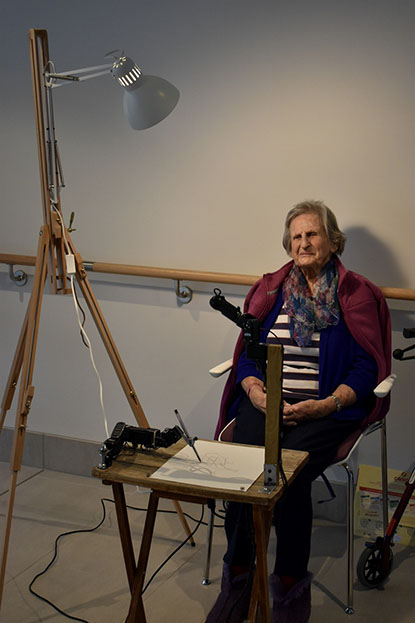Ideas, Progress & the Future
From an artist's easel to drawing robots
Internationally renowned artist Patrick Tresset is visiting the University of Canberra for the first time this month to showcase one of his installations Human Studies #1 with a drawing robot RNP (Robot Named Paul). Patrick and his RNP will visit the University of Canberra Hospital (UCH) as part of the University’s Distinguished International Visitor Program.
The visit is fundamental to his work spanning ten years of developing RNPs and teaching technology to mirror his style of drawing that has donned museums, galleries and other high-profile gatherings around the globe - as he explores new ventures and opportunities with the University of Canberra’s Faculty of Science and Technology’s robotics specialists.
For Patrick, the shift from traditional art to robotics was the best expression of his creativity conveyed through technology in an entertaining and skillful manner.
“After 13 years of pursuing my love for drawing and painting, I decided to tap into my other interest that dates back to my childhood of spending hours exploring, creating and inventing things using technology,” said Patrick.
Today, Patrick’s installations can include up to 20 RNPs all drawing according to his style, yet accurately depicting the subject whether a portrait or still-life.
I always have a robot drawing somewhere in the world.
Patrick’s passion for drawing brought about his first, and to-date, most successful robot, his Human Studies #1 RNP that draws portrait images while accurately filtering human emotion and expression.
Most people tend to be curious about Patrick’s installations that create a theatre of art while the RNPs draw the subject live.
“It is a continuous evolution as I refine and reconfigure the robots to adapt to certain situations, conditions or scenarios according to my artistic interests,” he said.
Patrick taps into research and uses advanced technologies including computer vision, artificial intelligence and cognitive computing in his artistic robotic endeavours.
“My robots are influenced by research into human behaviour, how artists interpret human behaviour and how humans relate to robots,” Patrick said.
“I developed them to create drawings that I like or find good and I have learnt the art of adapting my installations to the audience.”
Patrick has been exhibiting since 2010 and his Human Studies #1 RNP has produced little more than 30,000 drawings, most of which he owns and includes in his installations. His work has entertained audiences in major museums and institutions such as The Pompidou Center, Museum of Israel, Victoria & Albert Museum (London), Museum of Modern and Contemporary Art (Seoul), BOZAR (Brussels) and Prada Foundation (Milan).
I would say that the highlight of my career to date was exhibiting at The Pompidou Centre.
While art consumes Patrick’s vision and approach to his robotic inventions, he believes there is an opportunity for this form of art to make a meaningful difference to the lives of disabled people. “After a two-month stint in hospital last year, which was extremely boring, I realised that patients and in particular those who are confined by physical or mental challenges could benefit from some form of creative expression,” said Patrick.
“After a two-month stint in hospital last year, which was extremely boring, I realised that patients and in particular those who are confined by physical or mental challenges could benefit from some form of creative expression,” said Patrick.
“Art spans any divide and I believe that there are technological solutions that could be used to support creativity in people who may not have the physical ability to do so. By using technology that responds to eye or facial movements, for example, a person could create works of art that provide a window into their world and an outlet for their artistic expression.”
This makes Patrick’s exhibit at the University of Canberra Hospital pivotal to formulating a plan and funding approach to achieve this next creative invention.
Apart from his exhibit at the UC Hospital, Patrick’s work will be featured at the upcoming University of Canberra UnCover Event: The Human Cost of Robots on Thursday 20 June at the Howling Moon at the Rex Hotel.
Patrick’s visit has been funded through UC’s Distinguished International Visitor Program (CI Dr Damith Herath).
Words by Andy Visser and photos by Madeleine Wood.